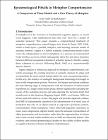| dc.contributor.author | Veale, Tony | |
| dc.contributor.author | Keane, Mark T. | |
| dc.date.accessioned | 2007-12-18T10:38:48Z | |
| dc.date.available | 2007-12-18T10:38:48Z | |
| dc.date.issued | 1995-12 | |
| dc.identifier.citation | [Author surname, forename]. 'Epistemological Pitfalls in Metaphor Comprehension: A Comparison of Three Models and a New Theory of Metaphor'. - Dublin, Trinity College Dublin, Department of Computer Science, TCD-CS-95-25, 1995, pp22 | en |
| dc.identifier.other | TCD-CS-95-25 | |
| dc.identifier.uri | http://hdl.handle.net/2262/12859 | |
| dc.description.abstract | [Introduction] If metaphor is to be viewed as a fundamental cognitive agency, as recent
work suggests, what ramifications does this view have for a model of
semantic memory? This paper presents a computational treatment of
metaphor comprehension, named Sapper (see Veale & Keane 1993, 1994),
which is built upon a parallel, adaptive, and learning network model of
semantic memory. Sapper is a hybrid symbolic/connectionist model which
views the interpretation of novel metaphors as a process of connectionist
bridge-building, a process which subsequently alters the activation dynamics
between different conceptual schemata in semantic memory, thereby causing
these schemata to interact (following Black, 1962) in a representationally
dynamic fashion.
Sapper employs a bottom-up approach to metaphor comprehension, one
which encourages the existing structure of semantic memory to shape and
accommodate the most natural interpretation for each concept juxtaposition.
In this way, the entirety of contingent background knowledge is brought to
bear on the interpretation process. However, the Sapper mechanism combines
the base-filtering stage of interpretation with the formation of initial match
hypotheses in a single connectionist phase, thereby significantly curtailing the
sweep of the matching process and side-stepping the factorial death that
models such as the Structure Mapping Engine (SME - see Gentner 1983) can
all too easily fall victim to. In fact, this paper will provide empirical evidence
that SME is fundamentally unsuited to the interpretation of a broad class of
metaphors that rely on an object-centred, as opposed to predicate-centred,
representation. These metaphors, which often find linguistic expression as
noun: noun comparisons, depend mainly upon the adequate representation of
object partonomies and taxonomies, rather than the representation of actions
and events toward which models such as SME are inherently biased. This
evidence casts serious epistemological doubts on the validity of these models
as cognitive theories of human metaphor comprehension. | en |
| dc.format.extent | 109678 bytes | |
| dc.format.mimetype | application/pdf | |
| dc.language.iso | en | en |
| dc.publisher | Trinity College Dublin, Department of Computer Science | en |
| dc.relation.ispartofseries | Computer Science Technical Report | en |
| dc.relation.ispartofseries | TCD-CS-95-25 | en |
| dc.relation.haspart | TCD-CS-[no.] | en |
| dc.subject | Computer Science | en |
| dc.title | Epistemological Pitfalls in Metaphor Comprehension: A Comparison of Three Models and a New Theory of Metaphor | en |
| dc.type | Technical Report | en |
| dc.identifier.rssuri | https://www.cs.tcd.ie/publications/tech-reports/reports.95/TCD-CS-95-25.pdf | |




